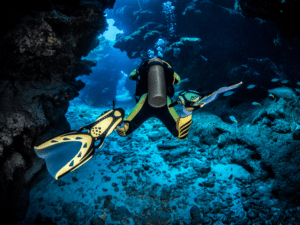Commercial diving is a difficult and dangerous profession that bears little resemblance to recreational diving. Divers are not paid to go spear-fishing or explore idyllic undersea coves, but instead to perform tough and hazardous tasks. For example, commercial divers may maintain offshore oil rigs or help build underwater structures that support oil and mineral production in the Gulf of Mexico and elsewhere. Although some accidents can’t be foreseen due to the nature of the work, many commercial divers are injured or killed as a result of negligence of dive boat operators, fellow divers, or their employers.

Commercial Diving and Its Many Dangers
Commercial divers work both in offshore and inshore waters in support of various civilian and government endeavors. Many companies hire professional divers to set up or repair underwater pipelines, oil platforms, hydroelectric dams, and to build or inspect bridges or pontoons. Other jobs done by professional divers include HAZMAT (hazardous materials) diving and nuclear diving. These branches of commercial diving are the most dangerous because divers must risk exposure to poisonous chemicals, raw sewage, and radioactive materials. There are also media divers who do underwater photography, scientific divers who carry out research, and naval divers, who perform various tasks for the military.
Commercial divers are well-trained and equipped with specialized gear to carry out their various tasks. Unlike recreational divers, they operate under strict protocols and must follow many safety regulations. They are also legally responsible not just for themselves but the other divers on their teams.
However, as well-trained as they are, professional divers are injured or killed on the job. Working in deep and often dangerous waters, commercial divers have to deal with many hazards. Among the estimated 5,000 to 7.000 professional divers in the U.S.,the annual death rate is 40 times higher than the average non-diving profession, according to an article by Washington reporter Linda Thomas.
Common Commercial Diving and Dive Boat Injuries
Commercial diver injuries come in two categories: dive-related and equipment related.
Dive-related injuries are caused by the environment in which divers work. According to the Occupational Safety and Health Administration (OSHA), the most common injuries include:
- Drowning
- Hypothermia
- Gas narcosis
- Dysbaric osteonecrosis
- Decompression illness
- Barometric pressure injuries
- Gas poisoning
Equipment-related injuries include:
- Propeller cuts or dive boat impact
- Underwater welding burns
- Injuries due to improper decompression tables
Examples of Commercial Diving Accidents
Unfortunately, in some instances, the risks of commercial diving leads to death. In May 2014, 24-year-old commercial diver Samuel Silverstein was working during a benefit concert held in Seattle, Washington when he was found 50 feet underwater, unconscious, close to Green Point at the Port of Seattle. Silverstein, along with his geoduck diving partner, Robert Mead, were diving off of a 40-foot commercial vessel when the accident occurred. According to reports, Silverstein was trapped in the line feeding air from the boat. The Occupational Safety and Health Administration (OSHA) began an investigation shortly after the accident.
In March of 2012, the Coast Guard began an investigation after a diver was killed 15 to 20 miles past Manasquan, New Jersey. The diver’s name was never released due to investigative reasons, but he was aboard the Gypsy Blood vessel before diving into the water. The Gypsy Blood, a 50-foot customized dive boat, has been under previous investigations after another person died in 2008. According to reports, a group of 10 divers were diving in 30-minute intervals During one of the sessions, fellow divers found the victim floating at the top of the water with his gear inflated.
As the Coast Guard began investigating the death, several other stories surfaced regarding severe injuries aboard the Gypsy Blood. In 2008, a 28-year-old female died during a 122-foot dive, and another diver lost consciousness the same year, and had to be airlifted and flown to the nearest hospital.
Compensation for Commercial Diving and Dive Boat Injuries
In order to qualify for compensation under the Jones Act and general maritime law, divers must be considered seaman and meet the criteria that determines what a seaman is, which includes the following:
- The diver must contribute to the work and function of the vessel
- The diver’s work must account for at least 30% on the vessel
For more detailed information on who qualifies as a seaman under general maritime law and the Jones Act, see our article Who Qualifies as a Seaman in Maritime Lawsuits?
Sources:
- http://cdiver.net/resources/commercial-diver/
- http://mynorthwest.com/646/2235341/Deadly-Dives–The-push-for-commercial-diving-regulations
- https://www.osha.gov/SLTC/commercialdiving/
- https://www.osha.gov/SLTC/commercialdiving/more.html
- http://www.nj.com/news/index.ssf/2012/03/deadly_dive_off_nj_coast_has_o.html